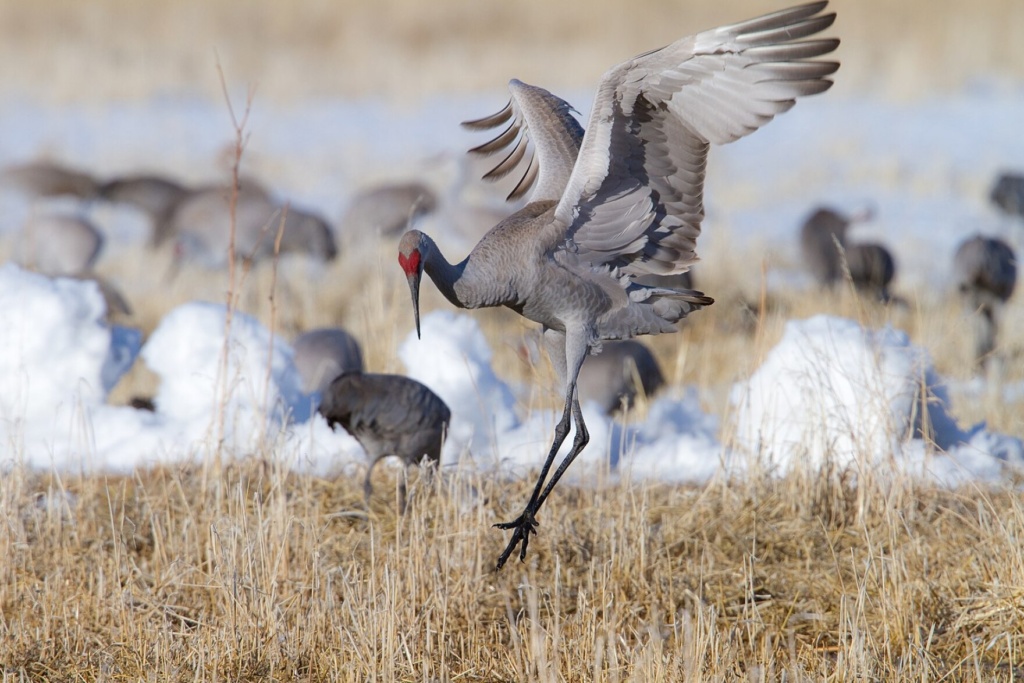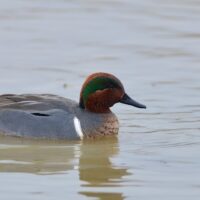In the next installment of the LBL Wildlife Report, Tracy Ross speaks to Woodlands Nature Station’s education coordinator Shannon Brockway about sandhill cranes.

Out of all the crane species, the most common in the United States is the sandhill crane. It has a gray color with distinct necks, legs, and beaks. “They look like wetland birds when you think of birds that are wading in the water,” Brockway begins. Another characteristic of sandhill cranes (and all other crane species) is a patch of red on adults’ heads.
The sandhill crane’s unique appearance helps it wade through shallow waters with ease, bending down and picking up plants, invertebrates, and seeds with its beak. These birds will also walk through open fields after they’ve been harvested, collecting leftover crop seeds.
While sandhill cranes will visit the Land Between the Lakes area, it is often sporadic and temporary. “We’re just a stop on their route,” Brockway says. “They’ll spend their nights in wetland areas, areas where they can basically stand in the water. That gives them some protection during the night when they’re sleeping. Big wetland areas, sand shoals that still have water surrounding them, those areas are where you’re likely to see cranes gathering up to spend the night.”
“We’ve seen cranes here on Honker Lake, but you never know exactly where they’re going to show up,” she continues. The cranes’ migratory route tends to veer more over central Kentucky than western, Brockway explains. “You’re going to see higher numbers if you go to wetland areas in central Kentucky.”
When they do arrive, however, it’s easy to hear it. “They have a really amazing call,” Brockway says. “It’s kind of a trumpeting, bugling call that really vibrates through the air. It’s hard to describe. It’s one of those things that once you hear it, you’re going to recognize it. There’s really nothing else like it. It’s an amazing sound.”
Another extraordinary trait of the crane is their mating rituals. Cranes mate for life, and both the male and female participate in raising the child. In all stages of mating, the two cranes will dance with each other. “It’s a really amazing thing to see two cranes leaping and twirling in the air,” Brockway adds.
Brockway says their size and silhouette have contributed to the association of sandhill cranes and elegance. “This is a bird that can be four to five feet tall. You can look them right in the eye. They have big, broad wingspans—around six, six and a half feet. I think all of the curves and angles of the bird appeal to a human’s idea of graceful and artistic. When you add in the fact that you can see a pair in a field leaping and dancing and twirling together, it just adds to the effect.”
Finally, Brockway points out a local lookalike to the sandhill crane. Herons, another wetland bird common in this area, look very similar to sandhill cranes. The difference, Brockway says, is in the flying and roosting.
“When they’re flying, cranes fly with their necks stretched all the way out. Herons will fold them back, almost into an “S” shape. If you see it standing in a tree, it is a great blue heron. Cranes spend their time in wetlands. They don’t have the ability to grasp tree branches. You’ll see a heron fly up into a tree and grab the branch. But cranes, instead, are going to be on the ground, in the water, or flying.”
For more LBL Wildlife Reports, click here. To learn more about the Woodlands Nature Station and Land Between the Lakes area, visit their website.






